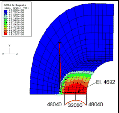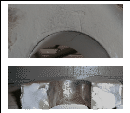
engineering & technology publications
ISSN 1759-3433
PROCEEDINGS OF THE SEVENTH INTERNATIONAL CONFERENCE ON COMPUTATIONAL STRUCTURES TECHNOLOGY
Fatigue Assessment of Bolted Bar Connections in Crane Structures
+Faculty of Mechanical Engineering, University of Maribor, Slovenia
*Institute of Thermomechanics, Prague, Czech Republic
This paper deals with the problem of service life evaluation of counterweight bar
bolted connection by means of computational analysis and experimental
testing [3,4,5].
The bolted joint fatigue is critical for a number of reasons: high ![]() values,
sensitivity of high strength steel to notch effects and the quality of surface treatment
(grinding, machined etc.), eccentricity and clearance of the joint inducing secondary
bending etc.
values,
sensitivity of high strength steel to notch effects and the quality of surface treatment
(grinding, machined etc.), eccentricity and clearance of the joint inducing secondary
bending etc.
Computational analysis was done in two steps. First, a stress field in the bar end
connection is determined by solving the contact problem between the bolt,
connection plates and the bar by means of the finite element analysis [1]. The
computational analysis provides the stress concentration points in the bar end, which
are also the most critical failure points. Second, the fatigue analysis has been
performed, where the local strain-life method (
![]() ) has been applied [2]. This
method is based on ration determination between the specific deformation and the
number of loading cycles
) has been applied [2]. This
method is based on ration determination between the specific deformation and the
number of loading cycles
[6,7,8].
Experimental fatigue tests of high strength steel bars were carried out in a specially constructed hydraulic pulsation machine. Complete description of experimental testing of presented problem is given in [3,4]. The main drawbacks of experimental testing are high costs and time consumption, although this approach is the most reliable way of component verification that is subject to high stresses and a large number of load cycles.
|
Computational analyses and experimental observations have shown that the
connection hole in the bar end is the most critical location for crack initiation and
final failure (Figure 1). Comparison of results is given
in Table 1. Average number
of loading cycles to failure determined with experiments is approximately
![]() loading cycles. A significant difference of results can be attributed to the fact that
bar specimens used in experiments was produced with thermal cutting process,
which resulted in initial surface damage. Although additional surface grinding was
applied, this apparently was not sufficient to alleviate sensitivity of high strength
steel to notches and other material imperfections (for instance micro-cracks,
inclusions etc.).
loading cycles. A significant difference of results can be attributed to the fact that
bar specimens used in experiments was produced with thermal cutting process,
which resulted in initial surface damage. Although additional surface grinding was
applied, this apparently was not sufficient to alleviate sensitivity of high strength
steel to notches and other material imperfections (for instance micro-cracks,
inclusions etc.).
|
- 1
- Abaqus Version 6.4-PR11. Online Documentation, Generated: 2003.
- 2
- Fe-safe Works Version 5. User's Manual, Generated: 2003.
- 3
- J. Kramberger, I. Potrc, G. Bombek, J. Flašker, "Fatigue assessment of high strength steel beams for crawler track cranes", Gép, 54 (10/11), 87-90, 2003.
- 4
- J. Kramberger, M. Šraml, I. Potrc, "Experimental Investigation of Fatigue Strength of High Strength Steel Bars", MATRIB 04, Vela Luka, Croatia, 2004.
- 5
- M. Šraml, J. Kramberger, M. Horvat, I. Potrc, "Numerical calculation of fatigue life of bar connection at crane structures", MATRIB 04, Vela Luka, Croatia, 2004.
- 6
- S. Suresh, "Fatigue of materials", Cambridge University Press (Second Edition), Cambridge, 1998.
- 7
- E. Zahavi, V. Torbilo, "Fatigue design", CRC Press, New York, 1996.
- 8
- N. Dowling, "Mechanical behaviour of materials", 2nd edition, Prentice Hall, 1998.
purchase the full-text of this paper (price £20)
go to the previous paper
go to the next paper
return to the table of contents
return to the book description
purchase this book (price £135 +P&P)


